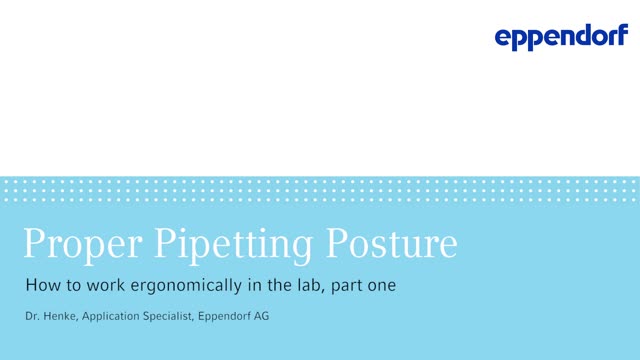菜单
CN | CNY
CN | CNY

Proper Pipetting Posture Prevents Muscle Strain During Work
实验室学院
- 移液与分液
- 人体工程学
- 移液器吸头
- 文章
Everyday work in a laboratory puts high demands on our bodies. Air-conditioned rooms, heavy equipment, and long series of repetitive movements strain different muscle groups. These burdens can lead to stiffness or pain in multiple parts of the body. Some of these can be relieved in the early state, but some expand and bury a risk of becoming chronic, like repetitive strain injury (RSI). This painful injury of the arm, wrist, and hand is widespread among pipette users, but could be prevented by the correct seating or standing position during work.
Today’s work in offices and laboratories is mainly done in two positions, either sitting or standing. After a long day of work, some feel a pain or stiffness in the lower back, neck, or shoulders. Some also complain about headaches and pain in the arm, wrist, and hand. Long working hours and repeated pipetting strains the arm and hand muscles. Repetitive strain injury (RSI) is a common result of this overuse among pipette users.
Most of us do not give pain too much attention when we are young. Usually, the pain disappears overnight and we resume pipetting as much as before and in the same position. But after years of work, the pain shows more often and more intensely; sometimes it does not disappear anymore with easy stretching and exercise. This injury can become chronic and lead to reduced power in the arm, making you unable to pipette long periods with a mechanical pipette. Medical treatments, physical therapist sessions, surgeries, or, in the worst case, inability to work are the consequences.
We can and should prevent body issues by considering our standing and seating position during daily work. If you want to see a proper seating position and how to arrange your worktable, watch our video on proper pipetting posture.
Most of us do not give pain too much attention when we are young. Usually, the pain disappears overnight and we resume pipetting as much as before and in the same position. But after years of work, the pain shows more often and more intensely; sometimes it does not disappear anymore with easy stretching and exercise. This injury can become chronic and lead to reduced power in the arm, making you unable to pipette long periods with a mechanical pipette. Medical treatments, physical therapist sessions, surgeries, or, in the worst case, inability to work are the consequences.
We can and should prevent body issues by considering our standing and seating position during daily work. If you want to see a proper seating position and how to arrange your worktable, watch our video on proper pipetting posture.
显示更少

Some simple points, like an upright seating position with the elbows close to the body and a chair positioned so that the elbows are slightly higher than the working table, already help a lot. Simply taking care to maintain a correct seating position can prevent and release pain. It can make you feel more relaxed during work and less tired in the evening.Additionally, you should take care when arranging instruments and tools on the worktable to have everything within reach. Think about your kitchen: you keep the plates, glasses, and cutlery in front or on top of items you need less often. It should be the same in the lab. Reaching up to grab a tool you often need, or regularly bending down to get sample tubes needed strains the whole body and makes work less effective and relaxed.
显示更少

